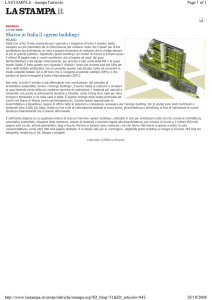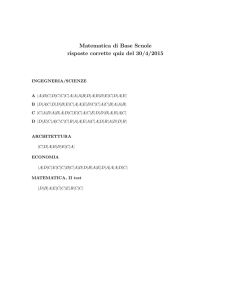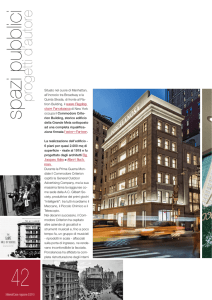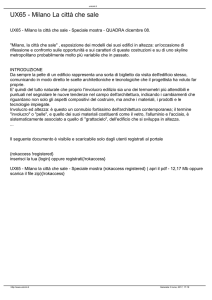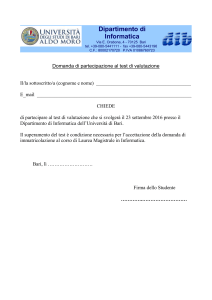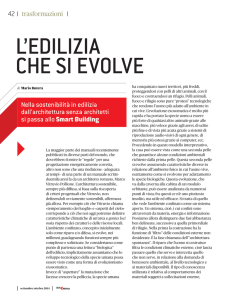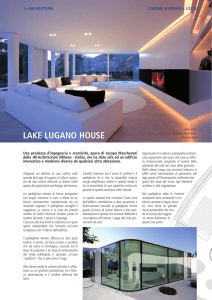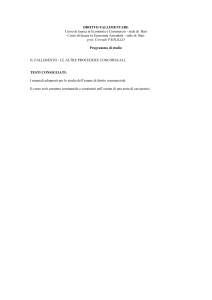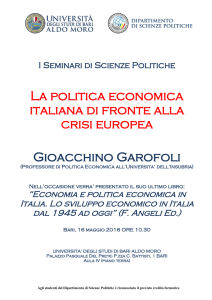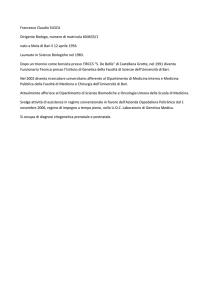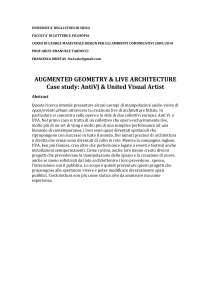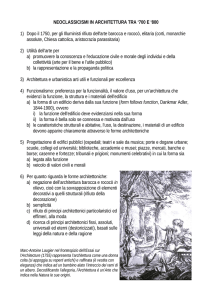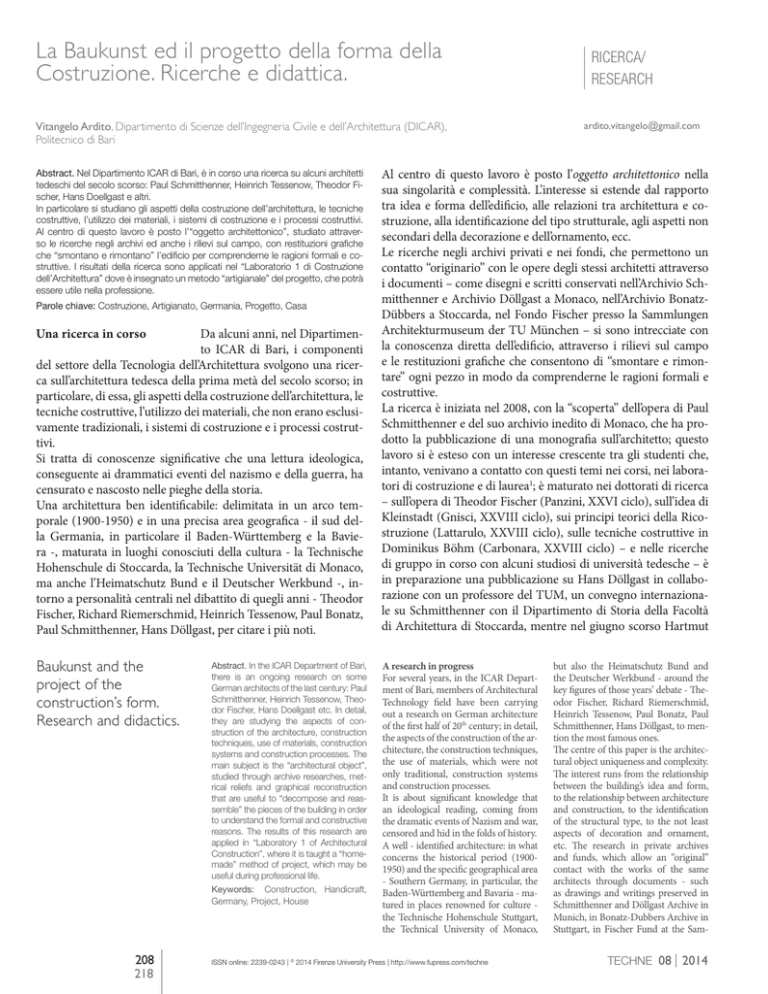
La Baukunst ed il progetto della forma della
Costruzione. Ricerche e didattica.
Vitangelo Ardito, Dipartimento di Scienze dell’Ingegneria Civile e dell’Architettura (DICAR),
Politecnico di Bari
Abstract. Nel Dipartimento ICAR di Bari, è in corso una ricerca su alcuni architetti
tedeschi del secolo scorso: Paul Schmitthenner, Heinrich Tessenow, Theodor Fischer, Hans Doellgast e altri.
In particolare si studiano gli aspetti della costruzione dell’architettura, le tecniche
costruttive, l’utilizzo dei materiali, i sistemi di costruzione e i processi costruttivi.
Al centro di questo lavoro è posto l’“oggetto architettonico”, studiato attraverso le ricerche negli archivi ed anche i rilievi sul campo, con restituzioni grafiche
che “smontano e rimontano” l’edificio per comprenderne le ragioni formali e costruttive. I risultati della ricerca sono applicati nel “Laboratorio 1 di Costruzione
dell’Architettura” dove è insegnato un metodo “artigianale” del progetto, che potrà
essere utile nella professione.
Parole chiave: Costruzione, Artigianato, Germania, Progetto, Casa
Una ricerca in corso
Da alcuni anni, nel Dipartimento ICAR di Bari, i componenti
del settore della Tecnologia dell’Architettura svolgono una ricerca sull’architettura tedesca della prima metà del secolo scorso; in
particolare, di essa, gli aspetti della costruzione dell’architettura, le
tecniche costruttive, l’utilizzo dei materiali, che non erano esclusivamente tradizionali, i sistemi di costruzione e i processi costruttivi.
Si tratta di conoscenze significative che una lettura ideologica,
conseguente ai drammatici eventi del nazismo e della guerra, ha
censurato e nascosto nelle pieghe della storia.
Una architettura ben identificabile: delimitata in un arco temporale (1900-1950) e in una precisa area geografica - il sud della Germania, in particolare il Baden-Württemberg e la Baviera -, maturata in luoghi conosciuti della cultura - la Technische
Hohenschule di Stoccarda, la Technische Universität di Monaco,
ma anche l’Heimatschutz Bund e il Deutscher Werkbund -, intorno a personalità centrali nel dibattito di quegli anni - Theodor
Fischer, Richard Riemerschmid, Heinrich Tessenow, Paul Bonatz,
Paul Schmitthenner, Hans Döllgast, per citare i più noti.
Baukunst and the
project of the
construction’s form.
Research and didactics.
Abstract. In the ICAR Department of Bari,
there is an ongoing research on some
German architects of the last century: Paul
Schmitthenner, Heinrich Tessenow, Theodor Fischer, Hans Doellgast etc. In detail,
they are studying the aspects of construction of the architecture, construction
techniques, use of materials, construction
systems and construction processes. The
main subject is the “architectural object”,
studied through archive researches, metrical reliefs and graphical reconstruction
that are useful to “decompose and reassemble” the pieces of the building in order
to understand the formal and constructive
reasons. The results of this research are
applied in “Laboratory 1 of Architectural
Construction”, where it is taught a “homemade” method of project, which may be
useful during professional life.
Keywords: Construction, Handicraft,
Germany, Project, House
208
218
RICERCA/
RESEARCH
[email protected]
Al centro di questo lavoro è posto l’oggetto architettonico nella
sua singolarità e complessità. L’interesse si estende dal rapporto
tra idea e forma dell’edificio, alle relazioni tra architettura e costruzione, alla identificazione del tipo strutturale, agli aspetti non
secondari della decorazione e dell’ornamento, ecc.
Le ricerche negli archivi privati e nei fondi, che permettono un
contatto “originario” con le opere degli stessi architetti attraverso
i documenti – come disegni e scritti conservati nell’Archivio Schmitthenner e Archivio Döllgast a Monaco, nell’Archivio BonatzDübbers a Stoccarda, nel Fondo Fischer presso la Sammlungen
Architekturmuseum der TU München – si sono intrecciate con
la conoscenza diretta dell’edificio, attraverso i rilievi sul campo
e le restituzioni grafiche che consentono di “smontare e rimontare” ogni pezzo in modo da comprenderne le ragioni formali e
costruttive.
La ricerca è iniziata nel 2008, con la “scoperta” dell’opera di Paul
Schmitthenner e del suo archivio inedito di Monaco, che ha prodotto la pubblicazione di una monografia sull’architetto; questo
lavoro si è esteso con un interesse crescente tra gli studenti che,
intanto, venivano a contatto con questi temi nei corsi, nei laboratori di costruzione e di laurea1; è maturato nei dottorati di ricerca
– sull’opera di Theodor Fischer (Panzini, XXVI ciclo), sull’idea di
Kleinstadt (Gnisci, XXVIII ciclo), sui principi teorici della Ricostruzione (Lattarulo, XXVIII ciclo), sulle tecniche costruttive in
Dominikus Böhm (Carbonara, XXVIII ciclo) – e nelle ricerche
di gruppo in corso con alcuni studiosi di università tedesche – è
in preparazione una pubblicazione su Hans Döllgast in collaborazione con un professore del TUM, un convegno internazionale su Schmitthenner con il Dipartimento di Storia della Facoltà
di Architettura di Stoccarda, mentre nel giugno scorso Hartmut
A research in progress
For several years, in the ICAR Department of Bari, members of Architectural
Technology field have been carrying
out a research on German architecture
of the first half of 20th century; in detail,
the aspects of the construction of the architecture, the construction techniques,
the use of materials, which were not
only traditional, construction systems
and construction processes.
It is about significant knowledge that
an ideological reading, coming from
the dramatic events of Nazism and war,
censored and hid in the folds of history.
A well - identified architecture: in what
concerns the historical period (19001950) and the specific geographical area
- Southern Germany, in particular, the
Baden-Württemberg and Bavaria - matured in places renowned for culture the Technische Hohenschule Stuttgart,
the Technical University of Monaco,
ISSN online: 2239-0243 | © 2014 Firenze University Press | http://www.fupress.com/techne
but also the Heimatschutz Bund and
the Deutscher Werkbund - around the
key figures of those years’ debate - Theodor Fischer, Richard Riemerschmid,
Heinrich Tessenow, Paul Bonatz, Paul
Schmitthenner, Hans Döllgast, to mention the most famous ones.
The centre of this paper is the architectural object uniqueness and complexity.
The interest runs from the relationship
between the building’s idea and form,
to the relationship between architecture
and construction, to the identification
of the structural type, to the not least
aspects of decoration and ornament,
etc. The research in private archives
and funds, which allow an “original”
contact with the works of the same
architects through documents - such
as drawings and writings preserved in
Schmitthenner and Döllgast Archive in
Munich, in Bonatz-Dubbers Archive in
Stuttgart, in Fischer Fund at the Sam-
TECHNE 08 2014
01 |
01 | Galleria ITU a Istanbul, archivio Bonatz Stoccarda
Istanbul ITU Gallery, Bonatz-Archive Stuttgart
vo di un particolare punto di vista ma ricondotto, insieme agli altri
contributi, alla conoscenza della natura costruttiva dell’edificio: la
definizione del sistema strutturale, dei materiali e delle tecniche
costruttive utilizzati, dei processi realizzativi, delle teorie compositive, ecc. L’aspetto centrale di questo metodo analitico risiede pertanto nella comprensione dell’”unità” dell’edificio: la forma rappresentativa e la sua costruzione sono sinteticamente espressi da un
termine usato da Schmitthenner, “Baugestaltung” cioè “concezione tettonica” dell’edificio. Al fondo del nostro interesse risiede una
idea di “formalizzazione della costruzione” che precede la forma
architettonica e che per questo è una “forma originaria” dell’edificio, una forma in apparenza “semplice” che non è il risultato di una
rinuncia ma l’affermazione di un principio. Un approccio che svela
in questa “origine” il senso “vero” della forma – “reine Sachlicheit”
è espressione tessenoviana che sottolinea un possibile percorso di
senso – e che, per questa ragione, è strettamente legato al progetto
di architettura nel tempo presente. Il matematico francese Laurent
Lafforgue, medaglia Fields (2002) e membro della Accademie des
Sciences, in una recente intervista dice che nella «ricerca della
verità […] occorre tenere in mente due cose: non perder di vista
l’essenziale e approfondire sempre la conoscenza del particolare».
Frank, professore emerito di Amburgo, ha presentato la recente
monografia su Paul Schmitthenner proprio a Bari.
Una metodologia di lavoro che è specifica della nostra Scuola di
Architettura di Bari: un lavoro d’equipe, realizzato con gruppi di
studenti e colleghi di altri settori disciplinari (ICAR 08-09, 12, 14,
17, 18) in cui il contributo di ognuno non è autonomo e descrittimlungen Architektur der TU München
– have intertwined with direct knowledge of the building, through field surveys and graphic renderings that enable
the “dismantling and reassembling” of
each piece in order to understand the
formal and constructive reasons.
The research began in 2008 with the
“discovery” of Paul Schmitthenner’s
work and his unknown archive of Munich, which led to the publication of
the essay on the architect; this work
was extended with a growing interest
among students that, in the meantime,
came in contact with these issues during the courses, in construction and
graduation labs1; it developed in PhDs
– with regards to the work of Theodor
Fischer (Panzini, XXVI cycle), the idea
of Kleinstadt (Gnisci XXVIII cycle),
the theoretical principles of the Reconstruction (Lattaruolo XXVIII cycle), the
construction techniques in Dominikus
209
Böhm (Carbonara, XXVIII cycle) - and
in the group researches with several
scholars of German universities; moreover a publication on Hans Döllgast
in cooperation with a professor at the
TUM, an international conference on
Schmitthenner with the History Department of the Faculty of Architecture
in Stuttgart are being prepared, while
last June, Hartmut Frank, emeritus professor of Hamburg, presented the recent
essay on Paul Schmitthenner right in
Bari.
A work methodology that is specific to
Bari’ s School of Architecture: a team
job, carried out with groups of students
and colleagues from other disciplines
(ICAR 08-09, 12, 14, 17, 18) in which
each contribution is not autonomous
and descriptive of a particular point of
view, but aimed, along with other contributions, at achieving knowledge of
the building’s constructive nature: the
V. Ardito
Per capire meglio l’ambito nel
quale si collocano questi architetti, e noi con essi, ricorriamo
alla diversa terminologia con la quale si indica il fenomeno dell’architettura: le espressioni “Baukunst”, “Architektur” e “Tektonik”.
La “Baukunst” è l’arte del costruire e sottolinea un fare artigianale,
che è insieme consolidato e innovativo, fissato nella iconicità della
manualistica e rinnovato nella pratica del progetto. Non intende
Una questione
terminologica
definition of the structural system, of
the materials and construction techniques that are used, of the processes of
realization, of the composition theories,
etc. The central aspect of this analytical
method, therefore, lies in the understanding of the building’s “unity”: the
representational form and its construction are briefly expressed by a term used
by Schmitthenner, “Baugestaltung” i.e.
“tectonic conception” of the building.
The core of our interest is the idea of
“construction formalization” that precedes the architectural form and that,
therefore, is an “original form” of the
building, an apparently “simple” form
that is not the result of a surrender, but
the statement of a principle. It is an approach that reveals in this “origin” the
“true” sense of the form - “reine Sachlicheit” is an expression of Tessenow that
emphasizes a possible itinerary of sense
- and that, for this reason, is closely re-
lated to contemporary architectural
design. The French mathematician
Laurent Lafforgue, Fields Medal (2002)
and a member of the Academies des Sciences, in a recent interview said that in
the «search for truth [...] you must keep
in mind two things: do not lose sight of
the essential and deepen the knowledge
of details».
A matter of language
In order to understand the context in
which these architects are placed, as well
as ours, we have to study the different
words used to refer to the phenomenon
of architecture: “Baukunst”, “Architektur” and “Tektonik.”
The “Baukunst” is the art of building, and
it stresses the handcraft nature, which is
both established and innovative, fixed in
the iconicity of manuals and renovated
in the practice of the project. It doesn’t
consider architecture as an art but as a
TECHNE 08 2014
02 |
l’architettura come arte ma come mestiere, come conoscenza tecnica, un processo di creazione della forma ottenuta attraverso la
sua costruzione, le sue regole ed i suoi linguaggi. “Architektur” è
un sostantivo “rinascimentale”, riferito soprattutto all’architettura
disegnata. Dürer usa questo termine parlando della città ideale,
Goethe dello stile nazionale con radici greco-gotiche. Essa è dunque forma stilistica che rispecchia i tempi, non solo (o non più)
costruzione. Tektonik è infine l’espressione formale della statica,
la configurazione degli elementi della costruzione secondo una
espressività derivante dalle linee di forza delle sollecitazioni; è il
termine più vicino alla modernità che, paradossalmente, deriva da
“Tektonik der Hellenen” dell’archeologo Karl Bötticher.
Questi tre modi di nominare l’architettura – Baukunst, Architektur, Tektonik –indicano che il nucleo originario risiede nel mestiere, nello stile, nella tecnica, ma ormai separati tra loro, espressione di una compiuta divisione dei saperi.
La nostra ricerca è interessata agli architetti che pensano l’architettura come Baukunst – ma conoscono l’Architektur e intuiscono
la Tektonik. Schmitthenner riteneva che l’architettura potesse solo
educare a fare buon uso delle conoscenze tecniche derivanti dai
mestieri. Non si deve pensare che è un punto di vista anacronistico, è invece un insegnamento autentico – non originale ma che
mira all’autenticità – perché educa ad una “postura del pensiero”
che si applica a diverse scale e con diversi materiali e processi. Anche oggi che l’informazione è globale, questa impostazione diven02 | Sezione della galleria ITU a Istanbul,
disegno DICAR Bari
Section of Istanbul ITU Gallery, drawing
DICAR Bari
03 | Scala dell’Alte Pinakothek a Monaco,
foto Vitangelo Ardito
Staircase of Alte Pinakothek in Munich,
photo by Vitangelo Ardito
210
ta ancor più necessaria, perché non si tratta solo di acquisire conoscenze ma di praticare una capacità di discernimento, che può
formarsi attraverso un “metodo induttivo ed esperienziale”. Non
a caso Schmitthenner riteneva l’architettura molto simile all’arte
della falegnameria.
Con questo metodo – che riconosce il formalizzarsi degli edifici a partire dalla conoscenza dai materiali e dalle tecniche, e ne
ripercorre i processi attraverso una operazione di “montaggio e
smontaggio” degli stessi, affinché diventi abitudinario processo di
conoscenza e di invenzione – è utile studiare edifici significativi e
03 |
profession, as technical knowledge, a
creative process of the shape obtained
through its construction, its rules and
its languages. “Architektur” is a noun of
the “Renaissance”, especially referred to
drawn architecture. Dürer uses this term
talking about the ideal city, while Goethe
refers to the National style with Greekgothic roots. It is therefore a stylistic
form that reveals the different ages, not
only (or no longer) construction. “Tektonik” is, finally, the formal expression
of statics, the configuration of the building’s elements according to an expressivity resulting from the lines of force of
the solicitations; this word is the closest
one to modernity and, paradoxically, it
comes from “Tektonik der Hellenen” of
archaeologist Karl Boetticher.
These three ways to refer to architecture
- Baukunst, Architektur, Tektonik – reveal that the original core lies in craft,
style, technique, but being by now sepa-
V. Ardito
TECHNE 08 2014
04 |
trovare corrispondenze e differenze, formulare concetti generali
comuni di tipo metodologico e speculativo ma anche scoprire soluzioni tecniche e formali.
Tre esempi della ricerca
Esaminiamo tre architetture
emblematiche che affrontano
un tema affine, un intervento nell’esistente, cioè più in generale,
il rapporto con le forme storiche dell’architettura stabilito utilizzando elementi della costruzione. Tre esempi che raggiungono
risultati esemplari, di forte oggettività per metodo e linguaggio.
Primo esempio è il progetto di trasformazione della Caserma Militare di Taşkişla nella sede della Facoltà di Architettura dell’Uni-
04 | Prospetto sud dell’Alte Pinakothek a
Monaco, foto Vitangelo Ardito
South side of Alte Pinakothek in Munich,
photo Vitangelo Ardito
211
rated from each other, the expression of
an accomplished division of knowledge.
Our research is concerned with architects who think about architecture as
Baukunst - but who are aware of Architektur and grasp Tektonik. Schmitthenner believed that architecture could
only educate to make good use of technical knowledge arising from crafts. You
should not think that this is an anachronistic point of view, it is instead an authentic teaching - not original but which
seeks authenticity - because it teaches a
“posture of thought” that applies to different scales and with different materials
and processes. This tendency becomes
more necessary today, because with the
globalization of information, the mere
gaining of knowledge is not as important as to make use of a discernment
ability, which can be formed through an
“inductive and experiential method.” It
is no coincidence that Schmitthenner
V. Ardito
versità Tecnica ad Istanbul (1944) di Paul Bonatz.
L’edificio esistente era un massiccio palazzo ottocentesco neorinascimentale (1848) di due piani, in pietra bugnata e mattone
bizantino intonacato, con un’ampia corte interna. I piani avevano
una altezza di 7 metri. Una ampia galleria voltata, larga 6 metri, attorniava la corte interna come un anello murario cavo. Dalla parte
esterno dell’edificio, uno spesso muro reggeva un impalcato ligneo
interno.
Paul Bonatz lascia inalterata la galleria sui due lati corti, mentre
la trasforma sui due lati lunghi, destinando l’esistente in spazi per
la didattica e laboratori. Qui, con un intervento minimo, anche
misurato sulle reali possibilità della manodopera esistente e utilizconsidered architecture very similar to
the art of carpentry.
With this method - that recognizes the
formalization of the buildings starting
from the materials and techniques, and
that traces its processes through the “assembly and disassembly” of the same, in
order to make it a methodic process of
knowledge and invention - it is useful to
study significant buildings and to find
similarities and differences, to formulate
common general concepts of a methodological and speculative type but also to
find technical and formal solutions.
Three examples of the research
Let’s examine three emblematic architecture cases that deal with a similar
issue, an intervention in the existing,
that is, more generally, the relationship
with the historical forms of architecture established using elements of the
building. Three examples that, thanks
to method and language, achieve exemplary results.
The first example is the transformation
project of Taskisla’s Military Barracks in
the Faculty of Architecture of the Technical University in Istanbul (1944) by
Paul Bonatz.
The existing building was a massive
nineteenth-century Neo-Renaissance
two-story palace (1848), in rusticated
stone and Byzantine plastered brick
with a large courtyard. The floors were
7 meters high. A large vaulted gallery,
6 meters wide, surrounded the inner
courtyard like a hollow ring wall. On the
exterior side of the building, a thick wall
carried an interior wooden boarding.
Paul Bonatz leaves the arcade unchanged on the two short sides, while
he transforms it along the two long ones
using the existent spaces for courses
and laboratories. Here, with minimal
intervention, also measured on the real
TECHNE 08 2014
05 | Particolare del prospetto sud in Klenze e in Doellgast, disegno DICAR Bari
05 |
Detail of south facade, project between Klenze and Doellgast, drawing DICAR Bari
zando mezzi elementari e materiali poveri, con la costruzione di
un muro di spina interno parallelo crea una nuova galleria, uno
spazio pubblico suggestivo che copre con un solaio in calcestruzzo
nervato con travi reiterate e intradossate. Il ritmo e la misura delle
bucature del prospetto sulla corte è ripetuto nel muro interno e determina, a sua volta, il ritmo delle travi a vista del soffitto, riuscendo a raggiungere con “nobile semplicità e quieta grandezza” una
omogenea monumentalità. Le due gallerie, illuminate su un lato in
modo indiretto ma efficace, vivono una drammatica luminosità e
ricordano i portici delle stoà, luoghi pubblici per la conversazione
nell’antica Grecia. La presenza di copie di sculture classiche, come
la Venere di Milo, agli incroci tra le nuove gallerie e i vecchi corridoi confermano questa volontà di memoria.
Bonatz imprime un nuovo carattere alla caserma con pochi ma efficaci interventi: due elementi della costruzione, una copertura in
calcestruzzo nervato e due muri con aperture ad arco ritmate, che
si configurano sulla base di ciò che già esisteva, la copertura lignea
a travoni e il muro perimetrale della corte. Così trasforma l’edificio in una Scuola di Architettura ancorata alla cultura occidentale,
una attestazione degli intenti pedagogici del vecchio professore
della “Stuttgart Schule”. L’intervento di Bonatz non ha cercato la
continuità stilistica né ad essa si è contrapposto; eppure ha trasformato l’edificio conservandone l’unità attraverso il linguaggio
senza tempo della tettonica, raggiungendo così un risultato profondamente “classico”.
Negli stessi anni in Germania si poneva il problema di ricostruire
i monumenti distrutti dalla guerra. A Monaco l’Alte Pinakothek
(1826-36) di Leo von Klenze (1784-1864) subiva gravi danni e con
furia iconoclasta si pensava di sostituire i ruderi con un edificio
“democratico” in ferro e vetro. I bombardamenti avevano prodot-
to la distruzione delle parti lignee – coperture e solai – un grande
squarcio nel prospetto sud e una voragine al centro. Hans Döllgast offriva un coraggioso progetto di ricostruzione (1946-57), nel
quale l’edificio allusivamente risorgeva dalle sue ceneri. Suggeriva
l’utilizzo dello stesso materiale ricavato dalle macerie, il mattone,
possibilities of the existing workforce
and using elementary means and poor
materials, with the construction of an
internal parallel central bearing wall, he
creates a new arcade,
a picturesque public space that he covers with a concrete floor nerved with
reiterated beams that create intradoses.
The rhythm and dimensions of the
openings on the court’s prospect is repeated in the interior wall and determines, in turn, the rhythm of the ceiling
beams at sight, managing to reach with
“noble simplicity and quiet grandeur” a
homogeneous monumentality.
Both walkways, that are illuminated on
one side in an indirect but effective way,
are endowed with a dramatic brightness and remind the arcades of the Stoa,
public places for conversation in ancient
Greece. The presence of copies of classical sculptures such as the Venus of
Milo, the intersections between the new
was the issue of rebuilding the monuments destroyed by the war. In Munich, Leo von Klenze’s (1784-1864)
Alte Pinakothek (1826-36) suffered
severe damage and, with iconoclastic
fury, the idea to replace the ruins with
a “democratic” iron and glass building
developed.
The bombing had destroyed the wooden parts - roofing and floors – and
produced a large gash in the southern
façade and a hole in the center. Hans
Döllgast offered a brave reconstruction
project (1946-57), according to which
the building, allusively, raised from its
ashes. He suggested the use of the same
materials obtained from the ruins, the
brick, that guaranteed the same extentbase building element, the same colour
hue, the same aging nuance.
The Alte Pinakothek was exemplary for
the museums’ buildings, with a linear
plan, a series of central rooms protected
212
galleries and the old corridors confirm
the architect’s will to refer to Hellenic
architecture.
Bonatz gives a new character to the barracks with few but effective interventions: two elements of the building, a
concrete ribbed roof and two walls with
arched openings that develop on the basis of what already existed, the wooden
beamed roof and the side-wall of the
court.
Thus he transforms the building into
a School of Architecture anchored to
Western culture, a statement of educational intent of the “Stuttgart Schule”’s
old professor. Bonatz’s intervention on
the one hand did not seek stylistic continuity but on the other did not oppose to
it; yet it transformed the building while
maintaining its unity through the timeless language of tectonics, thus achieving a deeply “classic” result.
In those same years in Germany, there
V. Ardito
to the North by lower small rooms and
to the South by a loggia for lighting and
resting; on the sides, two transversal
elements, with the entrances, stairs, offices. The building had an “I” shape. The
walk direction was linear and followed
the one impressed by the shape of the
building.
The damage of the war became an opportunity to rethink the building even
in its functional logic. Döllgast intervenes in the damaged areas and proposes a central entrance, he uses the side
area of the arcade, that was not used
very much, to create two full-length
“scissor” staircases, that forked from the
centre to the first floor, becoming the
rise and descent ramps of the art gallery.
Thus he improves the walk direction of
the museum without modifying the typological and structural plan.
What is extraordinarily interesting is the
reconstruction proposal of the exterior
TECHNE 08 2014
06 | Facciata del Municipio di Hechingen sulla piazza, foto Vitangelo Ardito
Façade of City hall in the platz of Hechingen, photo Vitangelo Ardito
che così garantiva la stessa misura-base dell’elemento costruttivo,
lo stesso timbro di colore, la stessa patina di invecchiamento.
L’Alte Pinakothek era un edificio esemplare nella progettazione dei
musei, con un impianto lineare, una serie di sale centrali protette a nord da piccole stanze più basse e a sud da una loggia per
l’illuminazione e il riposo; sulle testate due corpi trasversali, con
gli ingressi, le scale, gli uffici. L’edificio aveva una forma ad “I”. Il
verso di percorrenza del museo era lineare e seguiva la direzione
impressa dalla forma dell’edificio.
I danni di guerra diventavano l’occasione per ripensare l’edificio
anche nella sua logica funzionale. Döllgast interviene nei punti
danneggiati e propone un ingresso centrale, utilizza il corpo laterale della loggia poco utilizzata per realizzare due scale “a forbice”
a tutta altezza, che dal centro si biforcavano verso il primo piano,
diventando la rampa di salita e di discesa dalla pinacoteca. Migliora in questo modo il senso di percorrenza del museo senza
modificare l’impianto tipologico e strutturale.
Soprattutto è di straordinario interesse la proposta di ricostruzione del muro esterno meridionale. Döllgast chiama il suo me-
todo “interpretativo”, non tanto perché legato al suo punto di
vista soggettivo, ma perché teso a svelare, in senso etimologico,
la struttura profonda dell’architettura – che riconosce nella sua
costruzione – e da essa farsi guidare. E l’attenzione è proprio per
la partizione strutturale, che nel prospetto del palazzo è il principio ordinatore della partizione architettonica.
Qual è la differenza tra le due? Schmitthenner, esprimendo un
pensiero condiviso, distingueva tra decorazione e ornamento:
“decorazione” era l’ ”immateriale”, ciò che non è visibile ma pure
è necessario perché contenuto già nella costruzione – le proporzioni, il ritmo, la misura, le geometria – mentre “ornamento” è
il “materiale”, che è una “ricchezza” auspicabile che l’edificio richiede per diventare architettura. Ne consegue la distinzione tra
la configurazione, che è il principio della costruzione – determinata dalla “decorazione” e priva di ornamento – e l’architettura
che, col suo linguaggio, è espressione del suo tempo.
Döllgast nella ricostruzione assumeva solo l’aspetto costruttivo e
decorativo dell’edificio, perché proprio l’ornamentale era andato
irrimediabilmente distrutto. Ma così facendo conferiva alle parti
06 |
213
V. Ardito
TECHNE 08 2014
08 |
07 | Atrio interno Municipio di Hechingen, foto Vitangelo Ardito
Entrance hall of City hall in Hechingen, photo Vitangelo Ardito
08 | Schema strutturale del Municipio di Hechingen, disegno DICAR Bari
Structural model of City hall in Hechingen, drawing DICAR Bari
ricostruite una sospensione temporale e, al tempo stesso, una unità profonda con i resti, ricuciti e uniti alle parti “nuove”.
Attraverso il metodo “interpretativo” il progetto svela le ragioni
“ontologiche” del vecchio e riesce a porsi in unità con esso – anche Döllgast, come Bonatz, evidentemente non pratica una ricostruzione stilistica né una addizione moderna. Il vecchio muro di
Klenze, spoglio di ogni elemento, resta semplice struttura tettonica.
«È necessario un lavoro onesto, che risulti organico all’interno e
all’esterno, non di facciata e di rappresentazione. […] piuttosto
occorre il coraggio della nudità» (T. Fischer, discorso inaugurale
del Ledigenheim, Monaco 1927).
Il terzo esempio è il Municipio di Hechingen (1956), progettato da
Paul Schmitthenner; un edificio di nuova costruzione che, nelle
sue forme e nei riferimenti costruttivi, stabilisce una continuità col
vecchio edificio demolito.
southern wall. Döllgast calls his method
“interpretative”, not so much because it
is linked to his subjective point of view,
but because it is aimed at revealing, in
the etymological sense, the deep structure of architecture – that he recognizes
in his construction - and at being guided
by it. Hence his main attention is on the
structural partition, that is the ordering
principle of the architectural partition
on the building façade.
What is the difference between the two
architects? Schmitthenner, expressing
a shared thought, distinguished decoration from ornament: “decoration” is
the ‘”immaterial”, the non-visible that
is, nevertheless, necessary because already contained in the building - proportions, rhythm, measure, geometry
- “ornament” is the “material,” which is
a desirable value that the building needs
to be endowed with to become architecture. Hence the distinction between
214
Il nuovo Municipio ha la figura di una grande casa caratterizzata
da un grande tetto a capanna, posto sull’asse visuale di una stradapiazza. È attraverso il ripensamento di un certo tipo abitativo e
di un preciso sistema costruttivo, attinti dalla tradizione storica
del luogo ma interpretati attraverso l’artificio del “fuori-scala”, che
Schmitthenner riesce a pensare un edificio che sia al contempo
casa e palazzo, cioè modesto e monumentale, luogo quotidiano e
spazio collettivo.
Quindi Schmitthenner adotta il tipo edilizio della “Stadthaus”, la
casa quadrata con atrio centrale – il sedime, con lato di circa 20
metri, è quasi quadrato – che attinge dagli studi di Karl Gruber:
la pianta è divisa in 9 quadrati – uno schema palladiano – con il
quadrato centrale che diventa un grande atrio verticale troncoconico, a tutta altezza. All’esterno esso genera una lanterna al di
sopra del tetto, che si impone come elemento urbano verticale,
una torre civica che disegna il profilo della città.
07 |
“configuration”, which is the principle of
construction - determined by the “decoration” and devoid of ornament - and
“architecture” that, with its language, is
an expression of its time.
Döllgast only used the constructive and
decorative aspects in his reconstruction,
because the ornamental was what had
been irremediably destroyed. In doing
so he endowed the rebuilt parts with a
temporal suspension and, at the same
time, a profound unity with the original
elements.
Through the “interpretative” method
the project reveals “ontological” reasons of the old elements and manages
to maintain a strong connection with
them- obviously Döllgast as well, together with Bonatz, does not practice a
stylistic reconstruction or a modern addition. The old wall of Klenze, stripped
of all its elements, remains a simple tectonic structure.
V. Ardito
TECHNE 08 2014
09 |
La “Stadthaus” è ripensata ad una scala monumentale, confacente
la dimensione urbana dell’edificio, utilizzando lo schema strutturale a traliccio in una costruzione in cemento: in tal modo Schmitthenner riesce ad ottenere uno spazio interno con una grande luce
e a connotare con un carattere rappresentativo soprattutto le due
10 |
facciate principali del municipio. È una precisa “Baugestaltung”,
la “configurazione tettonica” di una struttura portante continua, e
non puntiforme, al perimetro: l’edificio risulta leggero negli spessori murari, ma insieme compatto e massivo nella figurazione.
Da un punto di vista tecnico, la translitterazione del sistema ligneo
impiegato con materiale più resistente, ha permesso di realizzare all’interno grandi solai nervati in cemento, sostenuti solo da
quattro pilastri centrali che delimitano l’atrio; mentre all’esterno
un muro perimetrale “portante”, realizzato con piedritti molto ravvicinati e parete collaborante, rende possibile il disallineamento
delle bucature ad ogni piano, in modo corrispondente all’uso che
se ne fa all’interno, la qual cosa per un verso mostra una grande
libertà compositiva e per l’altro conserva la memoria di importanti
“rathaus” tedeschi (Lindau, Bad Mergentheim).
Con una sapienza costruttiva e compositiva, il municipio di He09 | Laboratorio di Costruzione 1
dell’Architettura - Atelier, foto
Vitangelo Ardito
Laboratory 1 of Architectural
Construction – Atelier, photo by Vitangelo
Ardito
10 | Lab. di Costruzione 1 dell’Architettura
- maquette studente Elisa Ardito, foto
Elisa Ardito
Laboratory 1 of Architectural
Construction – maquette student Elisa
Ardito, photo by Elisa Ardito
215
V. Ardito
«We need an honest intervention, that
must appear organic inside and outside,
not a superficial and representational
one [...] We rather need the courage of
nudity »(T. Fischer, opening speech of
Ledigenheim, Munich 1927).
The third example is the City Hall of
Hechingen (1956), designed by Paul
Schmitthenner; a new building that, in
its shapes and building references, establishes continuity with the old demolished building.
The new City Hall has the shape of a
large house characterized by a large
gable roof, placed on the visual axis of a
street-square. It is through the rethinking of a certain type of housing and of
a specific building system, drawn from
the local historical tradition, but interpreted through the artifice of the “out of
scale”, that Schmitthenner can think of
a building that is both home and building, that is modest and monumental, an
TECHNE 08 2014
chingen riesce a trovare un giusto rapporto con la tradizione formale e costruttiva, cioè con la storia; ma nel contempo non disdegna una sperimentazione costruttiva che indica la strada di una
vera innovazione.
La didattica
Il luogo per verificare utilità e
attualità della ricerca, nei due
aspetti di una conoscenza teorica e di una metodologia sperimentabile, è la didattica in atto nel “Laboratorio 1 di Costruzione
dell’Architettura”, 2° anno, del Dipartimento ICAR di Bari, tenuto con la collaborazione del prof. Vincenzo Bagnato. In qualche
modo le due questioni sono simmetriche: il metodo di progetto
proposto nel Laboratorio, che sottolinea gli aspetti induttivi ed
esperienziali, riflette gli stessi aspetti che si sono mostrati sostanziali nel metodo di ricerca esposto, e che a loro volta sono
derivati da una conoscenza approfondita dell’oggetto di studio.
I contenuti teorici e gli obiettivi del Laboratorio sono ben espressi da Paul Bonatz: «c’è un solo modo per educare gli studenti:
tornare sempre agli elementi base. Poi loro cominceranno a riflettere invece di giocare con le forme e grazie a questa riflessione
aumenta la saggezza, la conoscenza e la bellezza».
Il metodo di lavoro fa tesoro dell’esperienza di Tessenow e Schmitthenner – quest’ultimo professore alla “Stuttgarter-Schule”
nel corso di “Baugestaltung”, 2° anno, un insegnamento comparabile al nostro Laboratorio – che individuavano come emblematica la casa di Goethe nel parco di Weimar, una semplice tradizionale casa di campagna, e la facevano ridisegnare e riprogettare agli allievi fino al minimo dettaglio, eleggendo questo esercizio a metodo di progetto. Ridisegnare diventava un atto critico
e una “variazione sul tema” del progetto. Allo stesso modo nel
everyday site and a place to share with
the community.
This way Schmitthenner adopts the
“Stadthaus”’ building type, the square
house with a central courtyard - the
base, with a side of about 20 meters, is
almost square - which he draws from
the studies of Karl Gruber: the plan
is divided into 9 squares - a Palladian
scheme - with the central square that becomes a large full-height vertical courtyard with the shape of a truncated cone.
On the outside, he creates a lantern on
top of the roof, which imposes itself as a
vertical urban element, a civic tower that
draws the profile of the city.
The “Stadthaus” is reconsidered on a
monumental scale, suiting the urban dimension of the building, using the structural scheme trellis in a concrete construction: this way Schmitthenner obtains an interior space fully illuminated
and endows the two main facades of the
216
City Hall with a representative character.
It is a precise “Baugestaltung”, the “tectonic configuration” of a continuous,
and not punctiform, load-bearing structure following the perimeter: the building is light in wall thickness, but compact and massive in the figuration.
From a technical point of view, the
transliteration of the wooden system,
used with more durable material, leads
to the realization of large floorings
nerved with concrete, supported only
by four central pillars that surround the
atrium; on the outside a bearing sidewall, made with very close piers and a
composite bearing wall, creates a misalignment of the openings on each floor,
corresponding to the use made of it on
the inside, that, on the one hand shows
a large compositional freedom and on
the other preserves the memory of important German “rathaus” (Lindau, Bad
Mergentheim).
V. Ardito
Laboratorio 1 di Costruzione di Bari viene indicata come rappresentativa dell’abitare mediterraneo la casa a torre – il tema di
progetto è una piccola casa a torre con un recinto, costituita da
una stanza di metri 5x5 ripetuta su 3 piani con una loggia in alto,
tutto disegnata fino al dettaglio – della quale non si segnala un
modello particolare perché molti esempi diffusi nel territorio ne
suggeriscono i tratti – per forma, materiali e tecniche esecutive,
tipo di costruzione, carattere, misure e dettagli. A questo punto
la scelta del materiale – pietra calcarea, mattone o legno – conduce ad un complesso di conoscenze tecniche non arbitrarie –
proprie dei mestieri – che individuano un sistema di elementi essenziali e corrispondenti, ordinati come i segni di un linguaggio
– propri dei manuali –; così si delineano quel tipo di conoscenze
più generali che chiamiamo “sistema costruttivo” o “sistema continuo murario” o “discontinuo trilitico” – quest’ultimo espresso
dal traliccio ligneo –, che non vengono imposti astrattamente
ma derivati da una approfondita conoscenza della natura dei
materiali e delle tecniche. La “disciplina tecnica” del mestiere e la
natura dei materiali possono così far apprendere un linguaggio
appropriato e poco esibito. La restrizione, infine, all’uso di soli
materiali e tecniche tradizionali è strumentale all’apprendimento
del metodo che, compreso, permette di affrontare con discernimento qualsiasi “novità”.
Grande importanza assume la familiarità con gli strumenti del
disegno, digitale e non – si favorisce il disegno manuale, con le
sue capacità di ricerca e di racconto del progetto – perché educa
ad una capacità di pensare la costruzione, di montare e smontare
l’edificio nei suoi componenti costruttivi, definiti fino al dettaglio, cercandone la coerenza tra le parti.
With constructive and compositional
wisdom, the Town Hall of Hechingen
finds the right relationship with the formal and constructive tradition, i.e. with
history; but at the same time it does not
mind a constructive experimentation
that shows the way towards true innovation.
The didactics
The place to verify the usefulness and
relevance of the research, in the two
aspects of a theoretical knowledge and
a testable methodology, is the course
afoot in “Laboratory 1 of Architectural
Construction”, 2nd year, of the ICAR
Department in Bari. Somehow the two
issues are symmetrical: the method of
the project proposed in the Laboratory,
that emphasizes the inductive and experiential aspects, reflects the same aspects
that revealed substantial in the enunciated research method, and that in turn
derived from a thorough knowledge of
the object of study.
The theoretical contents and objectives of the Lab are well expressed by
Paul Bonatz: «there is only one way to
educate students: to go back to the basic
elements. This way they will start meditating instead of playing with shapes
and thanks to this meditation wisdom,
knowledge and beauty will increase.»
The method draws inspiration from the
experience of Tessenow and Schmitthenner - a professor at the “StuttgarterSchule” of the “Baugestaltung” course,
2nd year, a discipline that we can compare to our Laboratory - singled out
Goethe’s house in the park of Weimar,
a simple traditional country house, as
an emblematic example and asked the
students to redesign and re-engineer
the house respecting the smallest detail,
electing this exercise as a design method. The redesigning became a critical act
TECHNE 08 2014
Conclusione
Oggi è necessaria la riscoperta
di queste esperienze del passato,
per nulla secondarie, che dimostrano come la storia dell’architettura non è solo quella che descrive una visione “progressiva” del
Modernismo, ma molte altre; è riduttivo, per queste storie, l’epiteto
di “altra” modernità o di architettura “tradizionalista”. Le modernità sono tante e della tradizione non si riesce a fare a meno.
Quindi è necessario da un lato un lavoro di conoscenza il più possibile neutro e oggettivo, legato ai documenti, ai testi e alle opere
dell’autore, entrando in rapporto “fisico” con l’architettura; dall’altro soprattutto scoprire l’attualità dell’esercizio del progetto “costruttivo”, in senso metodologico, derivante da una attitudine artigianale che trova le sue ragioni nel governo formale dei materiali
e delle tecniche. Questa attitudine, per nulla astratta, che guarda
l’opera di architettura dal particolare all’universale e viceversa, che
pensa tutto e unisce il piccolo e il grande in una logica stringente,
può iniziare dentro un Laboratorio di Costruzione.
Così negli anni, attraverso un esercizio disciplinato, nel lavoro
dell’architetto, che quando vuol essere antico sa anche essere contemporaneo, il punto di vista della Baukunst potrà mostrare la sua
efficacia, diventare una “postura del pensiero” che discerne ciò che
è necessario, e maturare in una cultura.
NOTE
Tesi di laurea svolte in DICAR/Bari sulle tematiche (relatore Vitangelo Ardito): Stoccarda: La villa urbana come forma elementare nello sviluppo della
città (A.A. 2007/08); Monaco di Baviera: L’altra Modernità (2008/09); Stoccarda II: Tessenow e Schmitthenner. La forma della casa (2009/10); Monaco II:
Costruzione ricostruzione come strumento di interpretazione del monumento
(2010/11); Monaco III: Costruzione dell’edificio urbano. Il piano e il progetto
nell’opera di Theodor Fischer (2011/12); Monaco IV: La costruzione dello spazio
1
and a “variation on a theme” project. In
the same way, in Laboratory of Building
1 of Bari, the “tower-house” is presented
as the typical Mediterranean dwelling - the theme of the project is a small
tower house with a fence, consisting of a
of 5x5 meter room repeated on 3 floors
with a balcony at the top, all drawn up
to detail – with no particular reference
to any model because many examples in
the territory suggest their features - for
shape, materials and executive techniques, type of construction, character,
dimensions and details. At this point,
the choice of the materials- limestone,
brick or wood - leads to a combination
of technical knowledge that is not arbitrary – typical of crafts –and that identifies a system of essential and correspondent elements, ranked as the signs of a
language – typical of manuals -; hence
that kind of more general knowledge
that we call “building system” or “con-
217
tinuous wall system” or “discontinuous
triptyque” is formed - the latter expressed by a wooden trellis -, which are
not imposed abstractly but derived from
a thorough knowledge of the materials’
nature and techniques. The “technical
discipline” of the craft and the materials’
nature can make us learn an appropriate and little displayed language. Finally,
the use of only traditional materials and
techniques is functional for a learning
method that, if understood, allows us
to face with discernment any kind of
“novelty”.
The familiarity with the tools of manual
and digital design takes on great importance - we favour manual design
because of its propensity to research and
ability to project description- because it
leads to the ability to “think” about the
building, to assemble and disassemble
its components, defined up to detail,
seeking coherence between the parts.
V. Ardito
sacro negli edifici di Theodor Fischer e Hans Döllgast (2011/12); Istanbul: La
costruzione e il luogo. Gli architetti tedeschi in Turchia: Bonatz, Taut (2012/13);
Stoccarda III: La stazione centrale di Stoccarda di Paul Bonatz. Il progetto, la
costruzione, la ricostruzione e l’attuale trasformazione (2013/14); Colonia: Il castello di Rothenfels e la costruzione dell’edificio sacro: Rudolf Schwarz e Romano
Guardini (2014/15).
REFERENCES
Italian essays:
Nardi, G. (1986), Le nuove radici antiche, Angeli Editore, Milano.
Vitale, A. Perriccioli, M. Pone, S. (1994), Architettura e Costruzione. Il problema della tecnica negli scritti dei protagonisti dell’architettura moderna, Angeli
Editore, Milano.
Di Pasquale, S. (1996), L’arte di costruire. Tra conoscenza e scienza, Edizioni
Marsilio, Venezia.
Barbisan, U. Masiero, R. (2000), Il labirinto di Dedalo. Per una storia delle tecniche dell’architettura, Angeli Editore, Milano.
Ardito, V. (2011), “La costruzione e la forma dell’architettura”, 1° Congresso
Internazionale Retevitruvio. Bari 2.6 maggio 2011, vol.4, p.1843-1852, ,Editore Polibapress, Bari.
Theoretical essays:
Tessenow, H. (1919), Handwerk und Kleinstadt, Cassirer, Berlin.
Wachsmann, K. (1930), Holzhausbau. Tecnik und Gestaltung, Ernst Wasmuth
Verlag AG, Berlin.
[trad. it.: Zorgno, A. M. (1992), Holzhausbau. Costruzioni in legno, Guerini
Studio, Torino].
AA. VV. (1931), Wasmuths Lexicon der Baukunst, Verlag E. Wasmuths, Berlin.
Schmitthenner, P. (1984), Gebaute Form. Variationen über ein Thema, Alexander Koch Verlag, Leifelden-Echterdingen [trad.it.: Schmitthenner, P. (1995),
La Forma costruita. Variazioni su un tema, Editrice Electa, Milano].
Conclusion
Today we need a rediscovery of these
past experiences, that are not secondary,
and that show how the history of architecture is not only the one that describes
a “progressive” vision of Modernism,
but many others; it is an understatement for these stories, to be referred to
as “other” modernity or “traditionalist”
architecture. There are several “modernities” and you cannot do without tradition.
Hence, on the one hand we need to work
on the neutral and objective knowledge,
linked to the documents, the material
and works of the author, entering into
a “physical” relation with architecture;
on the other hand we need to discover
the modernity of the constructive project exercise, in a methodological sense,
arising from a craft attitude that finds
its reasons in the formal government of
materials and techniques. This attitude,
not at all abstract, that looks at the architectural work from the particular to the
universal and vice versa, that considers
everything and that links the small and
the large in a compelling logic, can start
in a Building Lab.
This way, over the years, through a disciplined exercise in the architect’s job,
who knows how to be contemporary
even when being ancient, the point of
view of the Baukunst will show its effectiveness, becoming a “posture of
thought” that discerns what is needed ,
and develops in a culture.
TECHNE 08 2014
Kollhoff, H. (1993), Über Tektonik in der Baukunst, Vieweg & Sohn Verlag,
Braunschweig [trad. it.: Kollhoff, H. (2012), Sulla tettonica nell’arte edificatoria, Arnus University Book, Pisa].
Voigt, W. Frank, H. (2003), Paul Schmitthenner 1884-1972, Ernst Wasmuth
Verlag, Tubingen-Berlin.
On architects and architecture:
Nerdinger, W. (1985), Süddetsche Bautradition im 20. Jahrhundert. Architekten
der bayerischen Akademie der schönen Kunst, München.
Frank, H. (1985), Faschistische Architekturen. Planen und Bauen 1930-1945,
Christinans Verlag, Hamburg.
Durth, W. Nerdinger, W. (1993), Architekturnund Staedtebau der 30er/40er
Jahre, Deutsches Nationalkomitee für Denkmalschutz, Bonn.
On house construction:
Tessenow, H. (1909), Der Wohnungsbau, Callway, München [trad. it.: Garcia
Rojg, M. (1999), La costruzione della casa, Unicopli, Milano].
Schmitthenner. P. (1932, 1940, 1950,1984), Baugestaltung: Erste Folge. Das
deutsche Wonhaus, Konrad Wittwer Verlag, Stuttgart.
Frank, H. (1983), Lesebuch zur Wohnungsfrage, Pahl-Rugenstein Verlag, Köln.
Products of researches in DICAR/Bari:
Ardito, V. (2014), Paul Schmitthenner 1884-1972, Editore Gangemi, Roma.
Ardito, V. (2013), La costruzione non apparente della casa, Editore Polibapress,
Bari.
Ardito, V. (2012), La mite legge dell’arte. Il contributo teorico di Paul Schmitthenner, Editore Polibapress, Bari.
Panzini, N. (2012), La forma della casa (a cura di), Editore Polibapress, Bari.
Ardito, V. (2010), Monaco di Baviera. L’altra Modernita’, Editore Polibapress,
Bari.
PhD thesis at DICAR/Bari:
(co-tutor Vitangelo Ardito)
Panzini, N. (Phd Course XXVI ciclo) Stadtbaukunst. La costruzione della città
e l’opera di architettura di Theodor Fischer (1862-1938).
Gnisci, G. (Phd Course XXVIII ciclo) Teorie urbane e tecniche costruzione
nella città dell’Altra Modernità in Germania: l’idea di Kleinstadt (1900-1930).
Lattarulo, M.I. ((Phd Course XXVIII ciclo) Progettare con il passato: le ricostruzioni postbelliche in Germania come riflessione sulle tecniche di costruzione
dell’edificio (1945-1955).
Carbonara, G. ((Phd Course XXIX ciclo) Morfologia e innovazione costruttiva
nelle architetture sacre di Dominikus Böhm (1880-1955).
218
V. Ardito
TECHNE 08 2014

